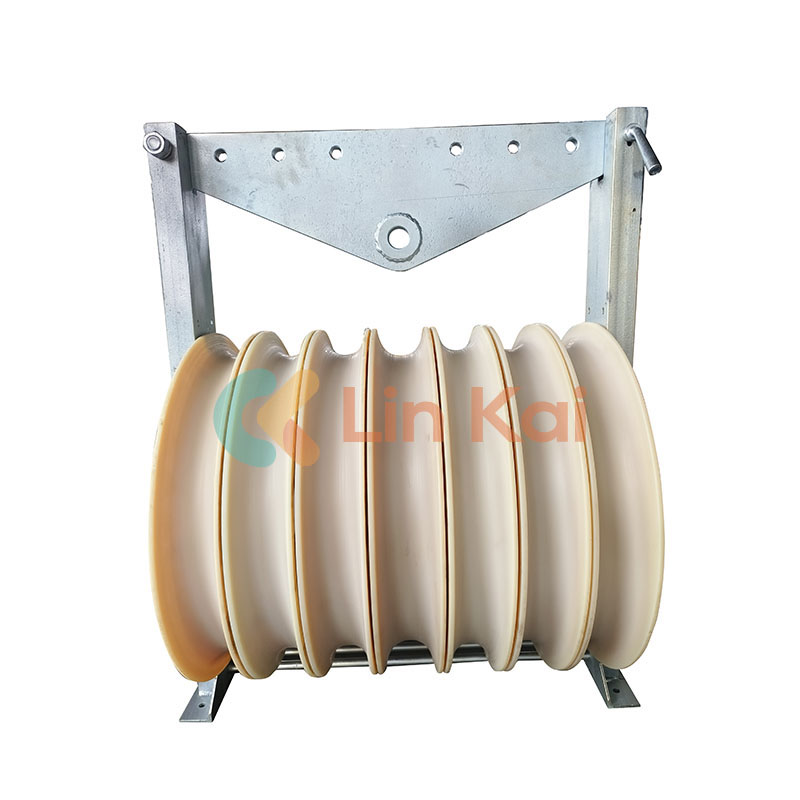Identifying and Mitigating Common Failure Modes of Large Diameter Stringing Blocks
2024-05-15
Large diameter stringing blocks are vital components in the installation and maintenance of power lines, guiding conductors safely and efficiently. However, like any mechanical device, they are susceptible to failure. Understanding the common failure modes of these blocks can help in preventive maintenance and enhance their longevity. Let's explore the typical ways large diameter stringing blocks can fail and how to mitigate these issues.
1. Sheave Wear and Damage
Failure Mode: The sheaves, or wheels, that guide the conductor can develop wear and tear over time. This includes grooves, nicks, or flat spots that can impair their ability to rotate smoothly.
Causes: Continuous friction with the conductor, exposure to harsh environmental conditions, and lack of proper lubrication are common causes.
Mitigation:
- Regularly inspect sheaves for signs of wear.
- Ensure proper lubrication as per the manufacturer’s recommendations.
- Use stringing blocks made of durable materials like hardened steel or aluminum alloy.
- Replace worn sheaves promptly to prevent further damage.
2. Bearing Failure
Failure Mode: Bearings that allow the sheaves to rotate can fail due to wear, corrosion, or lack of lubrication.
Causes: High operational loads, contamination with dirt or water, and insufficient lubrication contribute to bearing failure.
Mitigation:
- Perform routine maintenance checks on bearings.
- Keep bearings clean and well-lubricated.
- Use high-quality, sealed bearings to prevent contamination.
- Replace bearings that show signs of excessive wear or damage.
3. Structural Fatigue and Cracking
Failure Mode: The frame and structural components of the stringing block can develop cracks or suffer from metal fatigue, compromising their integrity.
Causes: Repeated stress cycles, overloading, and impact damage are primary reasons for structural fatigue.
Mitigation:
- Conduct regular visual inspections for cracks, especially at weld points and joints.
- Avoid overloading the stringing block beyond its rated capacity.
- Use blocks made from high-strength materials to resist fatigue.
- Employ non-destructive testing methods like ultrasonic or dye penetrant testing for early detection of internal cracks.
4. Corrosion and Rust
Failure Mode: Corrosion and rust can weaken metal components, leading to failure.
Causes: Exposure to moisture, chemicals, and harsh environmental conditions accelerates corrosion.
Mitigation:
- Apply protective coatings to metal surfaces to resist corrosion.
- Use corrosion-resistant materials such as stainless steel or treated aluminum.
- Store stringing blocks in dry, sheltered environments when not in use.
- Perform regular cleaning and maintenance to remove any corrosive elements.
5. Improper Lubrication
Failure Mode: Inadequate or excessive lubrication can lead to increased friction, overheating, and ultimately failure of moving parts.
Causes: Neglecting lubrication schedules, using incorrect lubricants, or over-lubricating components.
Mitigation:
- Follow the manufacturer’s lubrication guidelines precisely.
- Use the recommended type and amount of lubricant.
- Set up a regular lubrication schedule to ensure consistent maintenance.
- Train personnel on the importance of proper lubrication techniques.
6. Mechanical Deformation
Failure Mode: Mechanical deformation of parts, such as bent frames or distorted sheaves, can occur, compromising the block's functionality.
Causes: Accidental impacts, dropping the block, or excessive loading can cause deformation.
Mitigation:
- Handle stringing blocks with care to avoid impacts and drops.
- Ensure that the blocks are used within their specified load limits.
- Inspect the blocks for signs of deformation before and after each use.
- Implement protective measures, such as padding or storage in secure locations, to prevent accidental damage.
Conclusion
Understanding the common failure modes of large diameter stringing blocks is crucial for their maintenance and reliability. Regular inspections, proper lubrication, and adherence to operational guidelines are key to preventing these failures. By implementing these preventive measures, power line construction professionals can ensure that their stringing blocks remain in optimal condition, contributing to safe and efficient operations. Through vigilance and proactive maintenance, the lifespan of these indispensable tools can be significantly extended, ensuring continued performance in the demanding environments of power line work.



